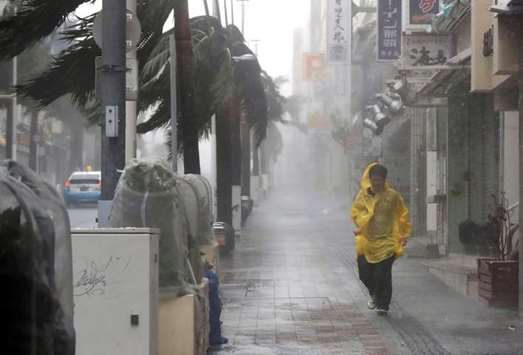A powerful typhoon sliced through Japan yesterday, injuring dozens, halting transport, and bringing fierce winds and torrential rain to areas already battered by a string of recent extreme weather episodes.
Typhoon Trami sparked travel disruption in the world’s third-biggest economy, with bullet train services suspended, more than 1,000 flights cancelled and Tokyo’s evening train services scrapped.
At least 84 people suffered minor injuries, many hurt by windows shattered in the driving wind, and one woman in her 60s was reported missing amid fears she was swept into a gutter. After pummelling Japan’s outlying islands including Okinawa, the storm made landfall south of the city of Osaka in the western part of the country around 8pm local time.
Yuji Ueno, an official in the town of Shirahama near where Trami made landfall, told AFP the winds were “enormous” and made it impossible to venture outside. “We saw incredible winds and rain. I stepped outside the city hall in the afternoon, and the rain was swirling in very strong wind. Enormous wind.” “It was difficult to stay standing. It was very scary,” said Ueno.
Trami, which at its height packed maximum gusts of 216km per hour, was expected to churn over most of the archipelago, weakening slightly but causing extreme weather into Monday, forecasters said.
Weather officials have warned of potential flooding and landslides and non-compulsory evacuation advisories have been issued to around 4mn residents, according to public broadcaster NHK.
More than 750,000 households, mainly in western Japan have lost power, according to local utilities and mobile phone services suffered disruption. As the typhoon barrelled east, rail authorities took the highly unusual step of cancelling evening train services in Tokyo, one of the world’s busiest networks, urging passengers to shelter indoors when the storm hits.
The typhoon did not hit the capital head-on but Tokyo still saw fearsome winds and lashing rain later Sunday and the streets of one of the world’s biggest cities were deserted. At the world-famous crossing in Shibuya, where thousands normally jostle every few minutes as the lights change, just a few hardy souls braved the horizontal rain and powerful gusts. Shops and business closed early as the capital hunkered down for the storm.
Trami is the latest in a string of extreme natural events in Japan, which has suffered typhoons, flooding, earthquakes and heatwaves in recent months, claiming scores of lives and causing extensive damage.
Osaka lay close to the path of the storm and its Kansai Airport, which is situated on reclaimed land offshore and suffered extensive damage in a storm earlier in September, closed early as a precaution.
Officials piled up sandbags to avoid a repeat of flooding seen during the previous storm. Speaking to AFP from a hotel near the airport, British businessman Richard Swart said: “It’s actually quite warm outside, very windy and with very heavy rain.”
“The airport is closed. There are very few people around and all the shops are shut. It’s really deserted,” added Swart, 56, from Durham in northern England. Even from the safety of the hotel, he said he could hear the wind “howling” outside.

A passer-by walks in heavy rain and wind caused by Typhoon Trami in the prefectural capital Naha, on the southern island of Okinawa, in this photo taken by Kyodo yesterday.


